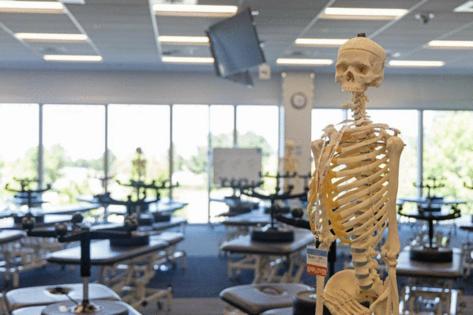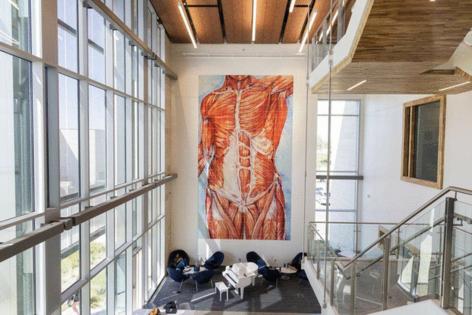Idaho State University may buy a private med school. What would it mean for Idaho's doctor shortage?
Published in News & Features
BOISE, Idaho — Idaho State University appears to be getting more serious about buying the Idaho College of Osteopathic Medicine in Meridian — at least, serious enough to spend $100,000 on a study that could help make the case for a purchase.
The state university has solicited an evaluation of the private medical college to determine the feasibility of and “the benefits and impacts associated with ... possible acquisition,” according to records obtained by The Idaho Statesman through a public-records request.
In June, ISU hired private consulting company Tripp Umbach to head the $100,000 study, which will include a cost assessment conducted by another business, according to an ISU spokesperson.
The move comes as state lawmakers have homed in on developing a plan for medical education in the state, which ranks worst in the nation in doctors per capita and so far has no public medical school.
ICOM, the state’s only medical school, was established in partnership with ISU in 2016, at a time when lawmakers didn’t have “the appetite” to fund a public medical school, according to ICOM’s president, Dr. Tracy Farnsworth. That’s changing, Farnsworth said.
Farnsworth told the Statesman by phone that ICOM’s owners, Rice University and private equity business TPG, have plans to divest the college, and that it’ll become more clear in the next six to 12 months whether ISU will be the one to buy it.
“I think in time, there’s not going to be a shortage of interested suitors,” said Farnsworth. “But what’s clear is the state of Idaho does have an interest. I think that’s great.”
There is “no active negotiation going on at this time” between the two schools, according to ICOM spokesperson Stephanie Dillon.
Farnsworth said conversations about a possible public acquisition began after “word (had) gotten out” about ICOM’s owners’ plans to divest, though he did not say exactly when.
Rice University in Houston has been the college’s single largest investor since it opened in 2018, while TPG, based in San Francisco, became a minority owner in 2022, replacing founder and investor Dan Burrell, for an amount the college did not disclose. Farnsworth said that it’s always been Rice University’s plan to eventually step away from the college.
“You and I and others have to understand how private equity works,” Farnsworth said. “In the case of Rice University ... they invest in projects like this so they can raise money for scholarships for their own students. So at some point, they have to sell.”
Farnsworth noted that ISU’s president, Robert Wagner, and the vice president of its Health Science Campus, Rex Force, sit on ICOM’s board of trustees. “So, they’re aware of the fact that the college will eventually sell to another entity,” he said. That awareness, he said, sparked an interest from the university and the state — dating back at least a year, according to reporting from Idaho EdNews.
Farnsworth said that’s a far cry from where the political temperature was in 2016 when the plan for the college was announced to “a fair amount of blowback” from state leaders who wondered “Why are we doing this?”
“Medical schools are very expensive,” he said, explaining why he believed the state opted not to open a public college roughly a decade ago. “In this case, private money came where public money was either unwilling or unable to go.”
According to Dillon, ICOM cost $34 million to build. The initial capital investment was estimated at $105 million, the Statesman reported in 2016.
What’s changed? For one, Farnsworth said, the college is growing and making a name for itself. It’s fully accredited as of 2022, and has graduated four classes, or nearly 600 students, 100% of whom have gone on to be placed in residencies, he said. Fifty-five ICOM graduates have been placed in residencies in Idaho.
And the classes have been growing, from 162 students in its first class in 2018 to 225 students being welcomed this fall. That includes roughly 35 native Idahoan students per year, Farnsworth said.
On a national scale, osteopathic medicine is a rapidly growing profession, and the number of osteopathic physicians has increased by 70% over the past decade, according to data from the American Osteopathic Association. That growth has come as distinctions between traditional allopathic physicians, or M.D.s, and osteopathic physicians, or D.O.s, have become more blurry, The New York Times reports. Osteopathic physicians can go on to pursue the same residency specialties as M.D.s but are distinguished in their “philosophy,” Dillon said, which at ICOM includes a focus on the “whole” patient and extra training in “hands-on medicine” and the musculoskeletal system.
With achievements both in the college and the field, Farnsworth said, there’s less financial cost and risk to getting involved with the college now than there was a decade ago. He also said there’s a growing need for “interprofessional” health care education, where students training for different health care professions learn in a more integrated way, instead of in “silos.”
“It would be a real, I think, feather in the cap of Idaho State University if they could find a way to wrap all of their very robust health profession programs, including nursing and pharmacy, ... around the school of medicine,” said Farnsworth.
Jenn Foreshee, the chief of staff to ISU President Wagner, told the Statesman by email that the university is “exploring the pros and cons of a potential acquisition” and is “evaluating potential opportunities for future growth and collaboration” with ICOM.
As part of that exploration, the university contracted Tripp Umbach to conduct a feasibility study that would quantify “the need for a state-owned medical school in Idaho,” assess “economic, educational and social benefits” of acquisition, and analyze anticipated effects of acquisition on Idaho’s physician workforce, according to a slide deck the consulting firm compiled in June that was obtained by the Statesman.
Tripp Umbach would also “lead the effort to secure a third-party assessment to determine the fair market value of ICOM,” one of the slides said. Another slide indicated that the valuation would be completed in August, but ISU spokesperson Emily Fransden told the Statesman that as of early September, no firm had yet been selected to conduct the valuation. The timeline included in the slide deck also suggested that the feasibility study would be finalized in October.
The contract with Tripp Umbach was paid for by auxiliary funds rather than state-appropriated funds, Frandsen said. The business, headquartered in Kansas City, Missouri, has consulted for more than 500 colleges or universities and conducted feasibility studies for over 100 medical schools, according to its slide deck.
On July 18, ISU distributed a “request for proposals” for the valuation, according to a request document, which no longer appears available on the university’s website. Another document, also no longer available, showed a set of questions and answers about the valuation request by ISU. The document indicated that ICOM was profitable for each of the fiscal years 2022 to 2024, owns no real estate, has roughly 100 full-time employees, and makes “almost all” of its revenue from tuition. It also stated that ICOM’s “current tuition is assumed to be ‘at market’ and continue after any transaction.”
ICOM’s tuition is just under $65,000 a year, not including fees or living expenses, according to the college’s website.
Talks around and study into the possible acquisition come as state lawmakers are taking a closer look at medical education for ways to alleviate Idaho’s ongoing struggle to recruit and retain physicians. Ranking last in the nation, Idaho had 192 active physicians per 100,000 people in 2022, down from roughly 196 in 2020, the Statesman previously reported. That disparity is worst in rural areas of the state, reporting showed. Idaho is also projected to be short more than 1,700 doctors by 2030, according to a study published in Human Resources for Health.
Under a 2025 state law, the state has formed a working group to focus on medical school opportunities for Idaho students. The group is tasked with developing “a medical education plan for the state” to be presented to the Legislature and governor in January 2026.
That law also directed the state to create 30 additional state-supported medical school seats over three years. The state subsidizes 40 medical students at the University of Washington and 10 at the University of Utah, said Brian Whitlock, president and CEO of the Idaho Medical Association.
The potential ICOM acquisition is part of the broader conversation around using education to change Idaho’s physician landscape, Farnsworth said. But whether or not the college is acquired, he said he wants to see ICOM house some of those state-supported seats.
“For many years now, the state of Idaho has supplemented the tuition of Idahoans that go to medical school at the University of Washington,” through what is known as the WWAMI program, as well as at the University of Utah, Farnsworth said. “They never have supplemented Idaho kids that go to ICOM. My hope is that they’ll do that — they ought to do that.”
Farnsworth said he “can’t imagine” that tuition wouldn’t be supplemented — for Idaho students who agree to return to Idaho to practice — if ICOM became part of ISU. The new state law directs that the 30 new seats not be part of WWAMI.
In the working group’s first meeting on Aug. 11, ICOM’s dean and chief academic officer, Dr. Kevin Wilson, discussed what the possible impacts of adding more Idaho students could be.
“Right now, at 30 to 40 Idaho students per year, we don’t have any problems making sure that they can all do (clinical) rotations in the state,” Wilson said. “If that grew to 80 or 90, it would be a challenge.”
Like many medical schools, ICOM offers a four-year program, where students attend two years of classes at the college and then spend two years in clinical clerkships at hospitals or other outpatient sites. Dillon, ICOM’s spokesperson, noted that roughly a third of each class is matched with clinical clerkships in Idaho, with preference to students from Idaho, but that “there are limited clerkship opportunities within the state.”
After completing their clerkships and graduating, physicians go onto residency training, which typically lasts three to eight or more years, Dillon said.
Farnsworth said ICOM’s owners plan to divest in the next several years. He expects that they will be “looking for a serious potential future owner” in the next one to two years. But that “hasn’t hampered our strategy, our momentum, our culture,” he said. “The school is not going away.”
“There’s always been an awareness that there will be an adjustment in ownership,” Farnworth added, noting that the college already went through one ownership change when TPG took over for Burrell. “It’ll just happen. We’re not particularly preoccupied by it.”
Still, the college president said he sometimes marvels why anyone would want to sell it. “I ask myself that question all the time,” he jested. “It’s a precious, valuable asset ... If I were them, I wouldn’t sell it.”
This summer, physicians from ICOM’s first class completed their residencies, and a handful returned to Idaho to practice medicine. Roughly 55% of the class went into primary care specialties — which include internal medicine, family medicine, emergency medicine and pediatrics — and have completed their residencies, Dillon said.
One, Dr. Joseph Saad, recently returned to Boise to work as an emergency medicine physician for the Saint Alphonsus Health System and to teach as an adjunct professor at ICOM, after completing his residency in St. Louis. Saad, who grew up in San Diego, told the Statesman that his time at ICOM and in a clinical rotation in the Treasure Valley made him want to pursue emergency medicine and to work in the Boise area.
Saad pointed to another challenge to retaining physicians and potential focus point for leaders: the state’s limited number of residency programs. A lot of physicians stay where they do their residencies, he said. “If the Treasure Valley started to open more residencies, then they would definitely flood in a bunch more doctors,” he said. “That’s obviously a long process ... but I think that’d be the next step.”
_____
©2025 The Idaho Statesman. Visit idahostatesman.com. Distributed by Tribune Content Agency, LLC.












Comments